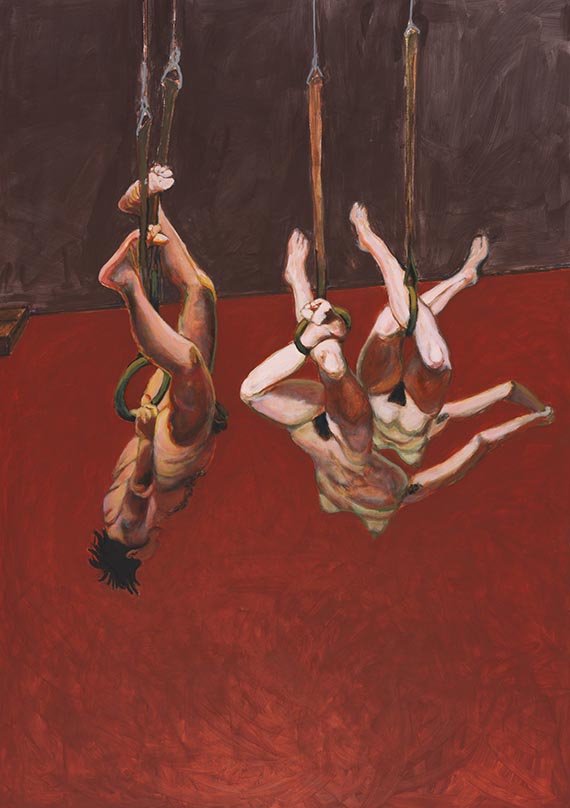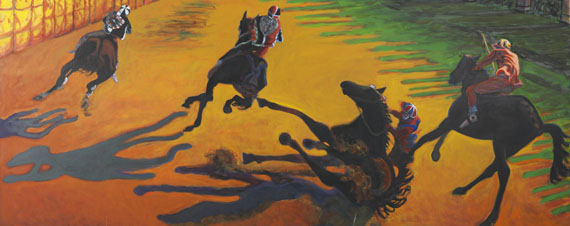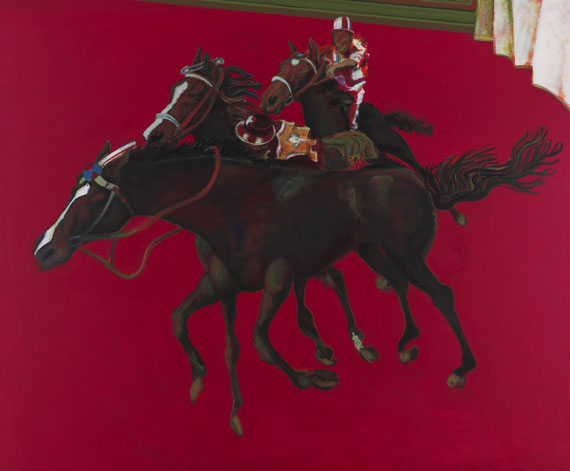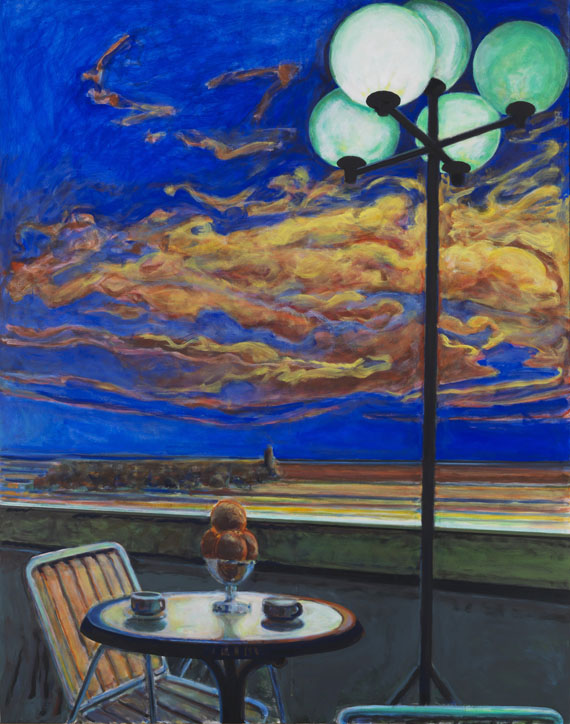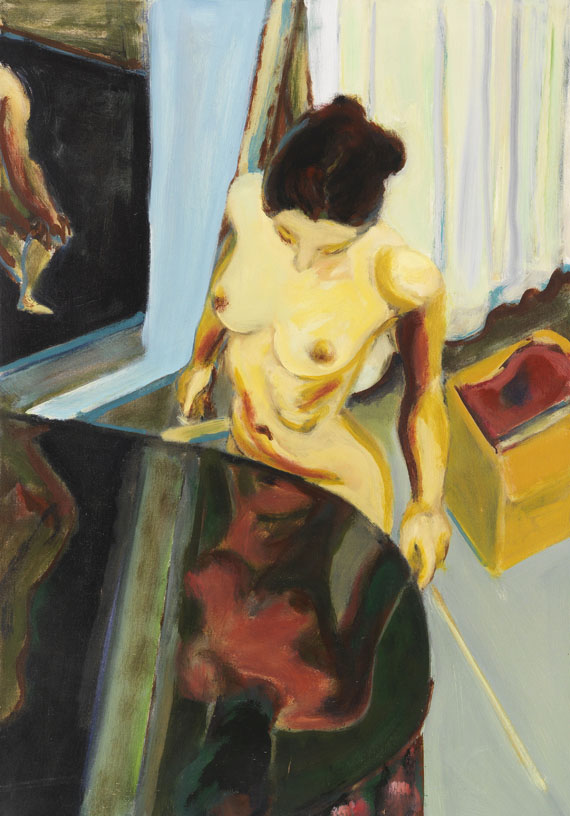Frame image
186
Norbert Tadeusz
Testa Drei Hängende, 2004.
Acrylic on canvas
Post auction sale: € 17,000 / $ 19,210
Testa Drei Hängende. 2004.
Acrylic on canvas.
Twice dated “August 04”, titled and inscribed “Himmel” on the reverse of the canvas. 300 x 210 cm (118.1 x 82.6 in). [AW].
• Distinctive physical presence through contrasting and intense colors.
• Body, color, and space are fundamental aspects in the painting of the Beuys student.
• Norbert Tadeusz's paintings challenge and shape a critical and creative eye.
• In 2020, a comprehensive retrospective was held at the renowned Museum Kunstpalast in Düsseldorf.
The work is listed in the Norbert Tadeusz Estate Archive, Düsseldorf, under the number “2004-10-06.” We are grateful to Ms. Petra Lemmerz for her kind support in cataloging this lot.
PROVENANCE: Galerie Wolfgang Gmyrek, Düsseldorf (with the gallery label on the reverse).
Private collection, Spain (acquired from the above in 2005).
Acrylic on canvas.
Twice dated “August 04”, titled and inscribed “Himmel” on the reverse of the canvas. 300 x 210 cm (118.1 x 82.6 in). [AW].
• Distinctive physical presence through contrasting and intense colors.
• Body, color, and space are fundamental aspects in the painting of the Beuys student.
• Norbert Tadeusz's paintings challenge and shape a critical and creative eye.
• In 2020, a comprehensive retrospective was held at the renowned Museum Kunstpalast in Düsseldorf.
The work is listed in the Norbert Tadeusz Estate Archive, Düsseldorf, under the number “2004-10-06.” We are grateful to Ms. Petra Lemmerz for her kind support in cataloging this lot.
PROVENANCE: Galerie Wolfgang Gmyrek, Düsseldorf (with the gallery label on the reverse).
Private collection, Spain (acquired from the above in 2005).
186
Norbert Tadeusz
Testa Drei Hängende, 2004.
Acrylic on canvas
Post auction sale: € 17,000 / $ 19,210
Buyer's premium, taxation and resale right compensation for Norbert Tadeusz "Testa Drei Hängende"
This lot can be purchased subject to differential or regular taxation, artist‘s resale right compensation is due.
Differential taxation:
Hammer price up to 800,000 €: herefrom 32 % premium.
The share of the hammer price exceeding 800,000 € is subject to a premium of 27 % and is added to the premium of the share of the hammer price up to 800,000 €.
The share of the hammer price exceeding 4,000,000 € is subject to a premium of 22 % and is added to the premium of the share of the hammer price up to 4,000,000 €.
The buyer's premium contains VAT, however, it is not shown.
Regular taxation:
Hammer price up to 800,000 €: herefrom 27 % premium.
The share of the hammer price exceeding 800,000 € is subject to a premium of 21% and is added to the premium of the share of the hammer price up to 800,000 €.
The share of the hammer price exceeding 4,000,000 € is subject to a premium of 15% and is added to the premium of the share of the hammer price up to 4,000,000 €.
The statutory VAT of currently 7 % is levied to the sum of hammer price and premium.
We kindly ask you to notify us before invoicing if you wish to be subject to regular taxation.
Calculation of artist‘s resale right compensation:
For works by living artists, or by artists who died less than 70 years ago, a artist‘s resale right compensation is levied in accordance with Section 26 UrhG:
4 % of hammer price from 400.00 euros up to 50,000 euros,
another 3 % of the hammer price from 50,000.01 to 200,000 euros,
another 1 % for the part of the sales proceeds from 200,000.01 to 350,000 euros,
another 0.5 % for the part of the sale proceeds from 350,000.01 to 500,000 euros and
another 0.25 % of the hammer price over 500,000 euros.
The maximum total of the resale right fee is EUR 12,500.
The artist‘s resale right compensation is VAT-exempt.
Differential taxation:
Hammer price up to 800,000 €: herefrom 32 % premium.
The share of the hammer price exceeding 800,000 € is subject to a premium of 27 % and is added to the premium of the share of the hammer price up to 800,000 €.
The share of the hammer price exceeding 4,000,000 € is subject to a premium of 22 % and is added to the premium of the share of the hammer price up to 4,000,000 €.
The buyer's premium contains VAT, however, it is not shown.
Regular taxation:
Hammer price up to 800,000 €: herefrom 27 % premium.
The share of the hammer price exceeding 800,000 € is subject to a premium of 21% and is added to the premium of the share of the hammer price up to 800,000 €.
The share of the hammer price exceeding 4,000,000 € is subject to a premium of 15% and is added to the premium of the share of the hammer price up to 4,000,000 €.
The statutory VAT of currently 7 % is levied to the sum of hammer price and premium.
We kindly ask you to notify us before invoicing if you wish to be subject to regular taxation.
Calculation of artist‘s resale right compensation:
For works by living artists, or by artists who died less than 70 years ago, a artist‘s resale right compensation is levied in accordance with Section 26 UrhG:
4 % of hammer price from 400.00 euros up to 50,000 euros,
another 3 % of the hammer price from 50,000.01 to 200,000 euros,
another 1 % for the part of the sales proceeds from 200,000.01 to 350,000 euros,
another 0.5 % for the part of the sale proceeds from 350,000.01 to 500,000 euros and
another 0.25 % of the hammer price over 500,000 euros.
The maximum total of the resale right fee is EUR 12,500.
The artist‘s resale right compensation is VAT-exempt.
Headquarters
Joseph-Wild-Str. 18
81829 Munich
Phone: +49 89 55 244-0
Fax: +49 89 55 244-177
info@kettererkunst.de
Louisa von Saucken / Undine Schleifer
Holstenwall 5
20355 Hamburg
Phone: +49 40 37 49 61-0
Fax: +49 40 37 49 61-66
infohamburg@kettererkunst.de
Dr. Simone Wiechers / Nane Schlage
Fasanenstr. 70
10719 Berlin
Phone: +49 30 88 67 53-63
Fax: +49 30 88 67 56-43
infoberlin@kettererkunst.de
Cordula Lichtenberg
Gertrudenstraße 24-28
50667 Cologne
Phone: +49 221 510 908-15
infokoeln@kettererkunst.de
Hessen
Rhineland-Palatinate
Miriam Heß
Phone: +49 62 21 58 80-038
Fax: +49 62 21 58 80-595
infoheidelberg@kettererkunst.de
We will inform you in time.




 Lot 186
Lot 186 